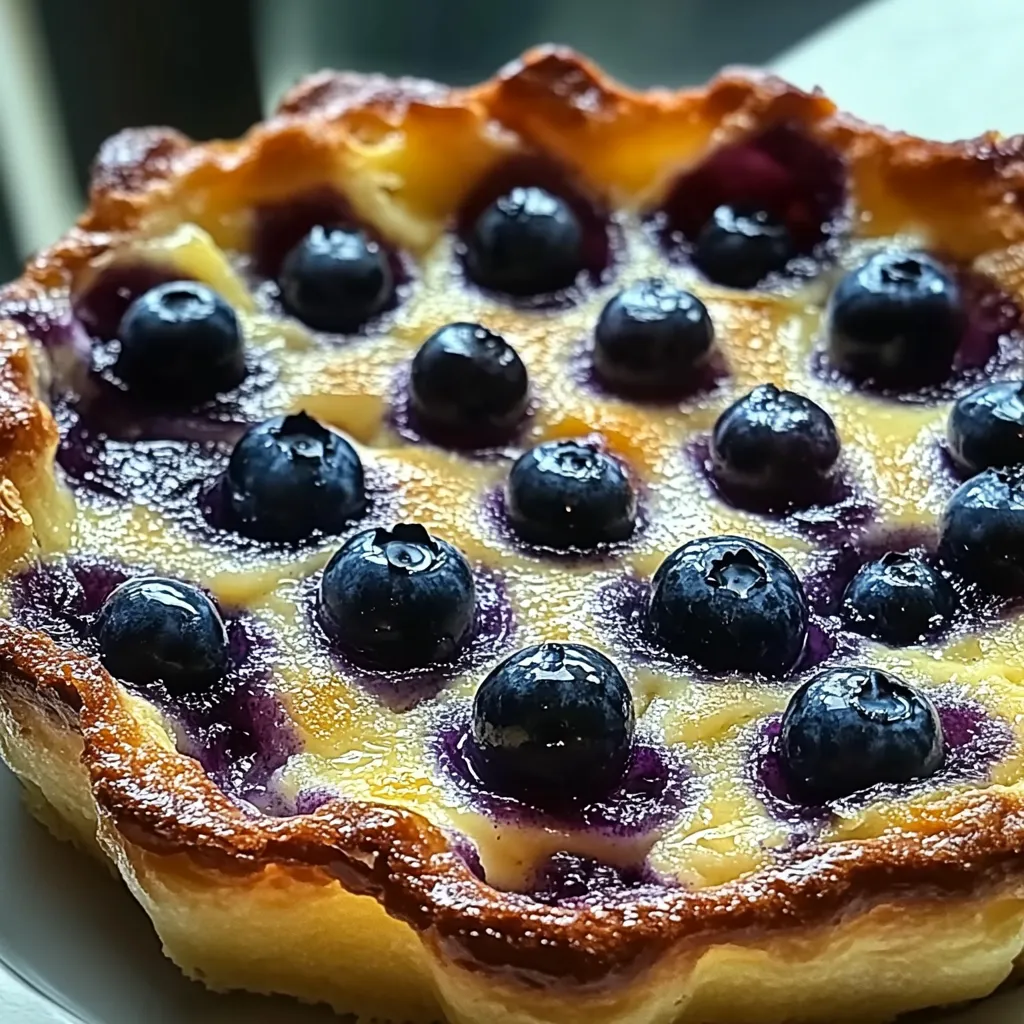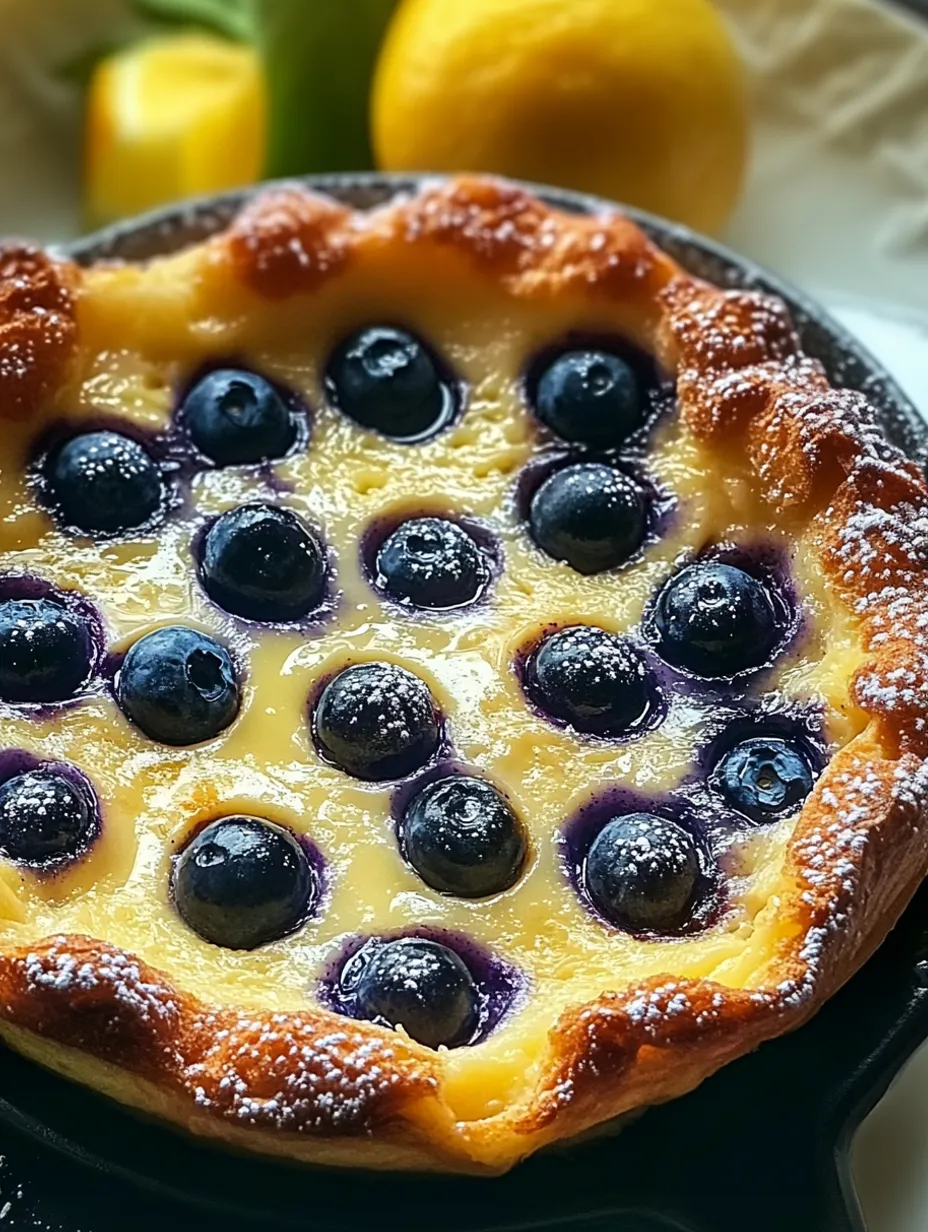 Save
Save
A blueberry lemon Dutch baby happens to be my favorite trick for impressing breakfast company without breaking a sweat. This enormous fluffy pancake does the work for you—expanding dramatically while baking as you enjoy your morning coffee, then dropping into this beautiful hollow of custard-like deliciousness dotted with soft, juicy blueberries. The bright lemon zest balances the sweetness just right.
I stumbled upon Dutch babies when my little ones were young and I got tired of standing around flipping countless pancakes while my family ate without me. The first time I pulled one from the oven, my husband actually gasped out loud. That rarely happens with my cooking, so I've kept making them ever since.
Your Ingredient List
- Eggs create that amazing puffiness—room temperature ones rise way better, as I found out through trial and error
- Milk creates the soft custardy center—we use whole at home, though 2% works pretty well too
- All-purpose flour gives the needed structure—nothing special required here
- Sugar complements the tangy fruit and lemon—it stays mildly sweet, perfect for morning meals
- Lemon zest adds that essential brightness—skip it and everything tastes dull
- Fresh blueberries cook down into soft, juicy spots—you can use frozen in a pinch but they tend to color the batter more
- Butter starts the sizzling magic—either salted or unsalted is fine
 Save
Save
My Cooking Method
Prepare Your BatterI beat those eggs till they're super frothy—more air means better rising. Next comes milk, sugar, vanilla, and salt. I add flour and lemon zest last, whisking just enough to get rid of big clumps. When I'm feeling extra lazy, I dump everything in the blender for a quick 10-second whirl.
Heat Your PanMy cast iron goes straight into the oven during preheating to 425°F. Don't skip this—a sizzling hot pan makes everything work properly. Once preheated, I drop in butter and watch it melt and bubble across the surface, careful not to let it brown too much.
Pour With SpeedThis part needs to happen quickly. I dump the batter into that hot buttery skillet—you'll notice it starts to set around the edges right away. Then I quickly scatter my blueberries across the top and rush it back into the oven. Any delay here means less puffiness later.
Leave It AloneNow comes the waiting game—no peeking for at least 15 minutes. My children always crowd around the oven window to watch it grow. Total baking takes about 20-25 minutes, until the sides climb up the pan walls and turn a nice golden color. The middle should look set but wobble slightly when moved.
The Big RevealFresh from the oven, everyone watches as it slowly sinks in the middle—totally normal for Dutch babies. I sprinkle powdered sugar while it's steaming hot, sometimes adding fresh lemon juice over top. What makes it incredible is that perfect mix of crispy outer edges and soft, tender center.
My mom always claimed she preferred traditional pancakes until she stayed over one weekend. She kept saying she liked "regular pancakes better" until she tasted this. After just two bites, she stopped eating and said, "I guess I've been making pancakes wrong for 70 years." Now she requests it every visit, pretending she's doing me a favor by asking for it.
Ways To Enjoy It
I carry the entire skillet to the table for the wow factor. Everyone grabs a wedge dusted with the classic powdered sugar. My husband covers his in maple syrup, the kids pile on whipped cream, and I prefer mine with a spoonful of Greek yogurt and honey. For special occasions, I'll set out small dishes of lemon curd and extra fresh berries.
Mix It Up
I often switch the fruit based on what's in season—summer peaches turn out amazing, and fall pears with a dash of cinnamon work wonderfully too. During Christmas, I swap in orange zest instead of lemon and sometimes splash a bit of Grand Marnier into the batter for fancy brunches.
Storing Extra Pieces
Truth be told—we rarely have any left. But when we do, I wrap individual slices and stick them in the fridge. A quick warm-up in the toaster oven (never microwave—it turns so rubbery!) brings them back to life pretty decently. Not quite as good as fresh-baked, but still better than most morning options.
 Save
Save
Smart Cooking Tips
- When dough rips during rolling, just push it together with your fingers—it forgives easily
- Sprinkle your counter with a bit of flour to prevent sticking, but too much makes tough dough
- For prettier slices when cutting your dough circle, cool it in the fridge for 10 minutes after adding filling
Both my Jewish and Polish grandmothers had competing rugelach recipes that became famous in our family. The Jewish version used sour cream instead of cream cheese, while the Polish one added a hint of cinnamon right into the dough. At holiday gatherings, you'd find both kinds on the dessert table, with relatives tactfully taking one of each. I eventually made my own version that mixes elements from both family traditions—using cream cheese for texture but adding that dash of cinnamon in the dough that my Polish grandmother swore by. Sometimes the greatest traditions grow and change while still honoring their roots.
Recipe FAQs
- → Why didn’t my pancake puff up much?
- Make sure your eggs and milk aren’t cold, the oven is piping hot, and the pan has been fully preheated with sizzling butter before adding the batter. Cold ingredients or a lukewarm pan can flatten it.
- → Can I make this without using a cast iron pan?
- Absolutely! Oven-safe pans like pie dishes work fine. Preheating the dish is key. Metal pans provide better results than ceramic or glass options.
- → Will frozen blueberries work okay?
- Frozen berries are fine; no need to let them thaw. Put them on the batter directly from the freezer. You might need to cook it for a minute or two more.
- → Can I mix the batter in advance?
- Yes, you can prep it and refrigerate for up to 4 hours. Just bring it to room temperature for half an hour before baking for the best results.
- → What other fruits can I swap in?
- Raspberries, blackberries, peaches, apples, or strawberries are great. Firmer fruits, like apples, might need a quick sauté in butter before adding.
- → Where does the name Dutch baby come from?
- It’s actually German, not Dutch! The name stems from a mispronunciation of 'Deutsch' (German), which got twisted into 'Dutch.'
Puffy Lemon Pancake
An oven pancake with crispy borders and a soft middle, bursting with fresh blueberries and a hint of lemon. Ideal for brunch or breakfast!
Ingredients
→ Batter
→ For Cooking
→ For Serving
Steps
Turn your oven to 425°F (220°C) and leave a 10-inch oven-friendly pan, like a cast iron skillet, inside to warm as you prep the rest.
Combine the eggs, flour, milk, vanilla, sugar, lemon zest, and salt in a bowl. Whisk until everything’s smooth and lump-free. The batter should be pretty thin.
Grab the hot skillet carefully with mitts. Toss in the butter and move it around until the whole bottom and sides are coated when melted.
After the butter's spread, pour the batter straight into the hot skillet. Quickly scatter the blueberries across the batter surface evenly.
Pop the pan back in the oven and bake for about 20-25 minutes. Look for big, puffy edges that turn golden brown while the middle stays tender.
Use mitts to take the Dutch baby out of the oven. It'll puff a lot but shrink down as it cools. Dust with powdered sugar and enjoy warm. Add syrup or curd if you'd like.
Notes
- This dish is similar to a big Yorkshire pudding or popover and rises dramatically in the oven.
- It's best to have eggs and milk at room temperature so the batter gets extra puffy.
- Don't worry when the Dutch baby deflates after baking—it always happens and it's totally normal!
Required Tools
- Mixing bowl
- Whisk
- 10-inch skillet (cast iron or oven-safe)
- Oven mitts
- Measuring tools (cups + spoons)
Allergy Information
Check each ingredient for potential allergens and consult a healthcare professional if needed.
- Uses wheat (flour)
- Includes dairy (milk, butter)
- Contains eggs
Nutritional Facts (per serving)
These details are provided for informational purposes and aren't a substitute for medical advice.
- Calories: 225
- Fats: 12 g
- Carbohydrates: 24 g
- Proteins: 8 g
